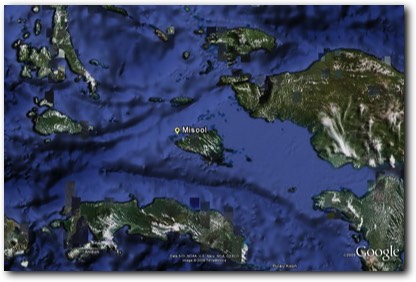Misool is the southernmost island of the Raja Ampat group in Indonesia. With an area of around 2000 km², it is one of the larger Raja Ampat islands. The interior of the island is rough and more or less uninhabited also steep mountain ridges that fan out far into the sea make it very difficult to get on land or even cross the island.
Saltwater crocodiles are still found in the extensive mangrove forests of Misool. Until a few years ago, diving in Misool was only possible with the help of a handful of live aboards. Today, however, a visit to the great dive sites around Misool is part of most of the 10-day tours in the Raja Ampat area.
Saltwater crocodiles are still found in the extensive mangrove forests of Misool. Until a few years ago, diving in Misool was only possible with the help of a handful of live aboards. Today, however, a visit to the great dive sites around Misool is part of most of the 10-day tours in the Raja Ampat area.
For those, who do not like diving from a live aboard, there is nowadays a land-based diving opportunity in the southeast of Misool, on one of the offshore islands.
Misool Eco Resort
The construction of this resort in such a remote area must have been an adventure in itself and is a remarkable achievement by Englishman Andy Miners, who took several years to build this resort with the help of German Thorben Niemann. When I first visited the unfinished resort in 2007, it still looked pretty desolate and one could only guess what the resort would look like once it was completed.
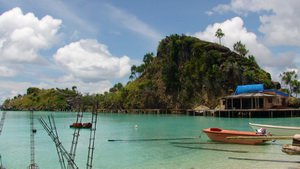
Misool Eco 2007: View of the Lagoon
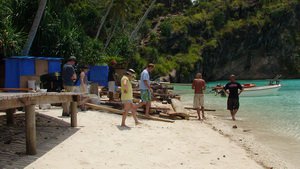
Misool Eco 2007: Construction site of the Restaurant
The resort opened in late 2008 and is of course no longer as chaotic looking as it was the year before. The following pictures were shot in March 2009 and show that a lot of work has been done in the meantime.
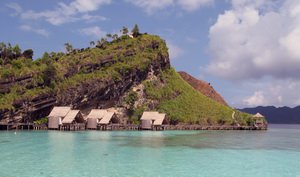
Misool Eco 2009: View of the Lagoon
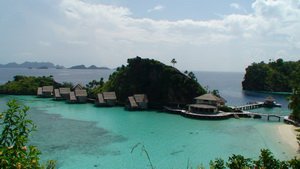
Misool Eco 2009: Water Bungalows
The guests of the Misool Eco Resort are picked up in Sorong and then have to accept a four to five hour, strenuous speedboat crossing. This tour burns a lot of fuel, which doesn't quite fit into the eco-label the resort has given itself.
Eco is also more about the way the resort was built. Driftwood and 'naturally' felled wood from the area were used. However, I doubt whether this wood will withstand the harsh climatic conditions of the tropics in the long term. The cheaper huts in the neighboring bay looked pretty run down after only a year of use. However, this was not the case for the more elaborately manufactured water bungalows in the lagoon. They made a very good impression during our visit in spring 2009.
The base's restaurant is located on the mini beach, but it seems to me that it is a bit too small to offer enough space for all guests. We also noticed the many mosquitoes, even during day time. You probably won't leave Misool Eco Resort without mosquito bites.
The dive center is very well equipped. Nitrox is also offered to guests.
Eco is also more about the way the resort was built. Driftwood and 'naturally' felled wood from the area were used. However, I doubt whether this wood will withstand the harsh climatic conditions of the tropics in the long term. The cheaper huts in the neighboring bay looked pretty run down after only a year of use. However, this was not the case for the more elaborately manufactured water bungalows in the lagoon. They made a very good impression during our visit in spring 2009.
The base's restaurant is located on the mini beach, but it seems to me that it is a bit too small to offer enough space for all guests. We also noticed the many mosquitoes, even during day time. You probably won't leave Misool Eco Resort without mosquito bites.
The dive center is very well equipped. Nitrox is also offered to guests.
Dive sites around Misool
From a diver's point of view, the Misool Eco Resort is situated in a top location. Most diving spots can be reached in a short time with the resort's speedboats and these spots offer first-class diving. The house reef is also ok, and offers interesting critter discoveries especially during night dives.
Most of the resort's dive sites are also visited by the live aboards which pass by on their itineraries. However, the diving guides of the resort know these dive sites better than those of the diving ships, which often only pass through this area at intervals of several weeks.
All dive sites are covered with fantastic soft corals and you will find the finest hard coral landscapes. Again and again one encounters large schools of fish - yellow-lined snappers but also mackerel are common, and there is a manta cleaning station with a fairly good chance of actually seeing manta rays.
Some dive sites are presented here briefly. However, the naming is not clear. The resort names some dive sites differently than the live aboards that visit Misool.
Fiabacet and Fiabacet Kecil
There are several good dive sites here, which are particularly popular among underwater photographers. There are openings in the reef you can dive through which allow wonderful backlit shots with colored soft corals in the foreground. Large schools of butterfly fish and barracuda are often seen in the open water, and pygmy seahorses (H. bargibanti and H. denise) often sit on the gorgonians, even at shallow depths.
Pulau Boo
A beautiful underwater landscape with fan corals (H. denise) and beautiful soft corals. Lots of schools of fish.
Karang Warakraket (Magic Mountain)
An underwater mountain with very nice growth of hard corals. In the deeper part there are large schools of yellow-lined snappers and many lionfish lie in wait. Mantas also come here to be cleaned. In the shallower part there are many butterfly fish in the current.
Gorgonian Passage
As the name suggests, this dive is a drift dive in a narrow passage between two islands. The cliffs here are full of fan corals (H. bargibanti) and at the end you will find yourself in a very beautiful coral garden.
This list is far from exhaustive. To the west of Misool are the famous Blue Water Mangroves with a unique mangrove landscape, soft corals and - unfortunately - with one or the other saltwater crocodile.
Most of the resort's dive sites are also visited by the live aboards which pass by on their itineraries. However, the diving guides of the resort know these dive sites better than those of the diving ships, which often only pass through this area at intervals of several weeks.
All dive sites are covered with fantastic soft corals and you will find the finest hard coral landscapes. Again and again one encounters large schools of fish - yellow-lined snappers but also mackerel are common, and there is a manta cleaning station with a fairly good chance of actually seeing manta rays.
Some dive sites are presented here briefly. However, the naming is not clear. The resort names some dive sites differently than the live aboards that visit Misool.
Fiabacet and Fiabacet Kecil
There are several good dive sites here, which are particularly popular among underwater photographers. There are openings in the reef you can dive through which allow wonderful backlit shots with colored soft corals in the foreground. Large schools of butterfly fish and barracuda are often seen in the open water, and pygmy seahorses (H. bargibanti and H. denise) often sit on the gorgonians, even at shallow depths.
Pulau Boo
A beautiful underwater landscape with fan corals (H. denise) and beautiful soft corals. Lots of schools of fish.
Karang Warakraket (Magic Mountain)
An underwater mountain with very nice growth of hard corals. In the deeper part there are large schools of yellow-lined snappers and many lionfish lie in wait. Mantas also come here to be cleaned. In the shallower part there are many butterfly fish in the current.
Gorgonian Passage
As the name suggests, this dive is a drift dive in a narrow passage between two islands. The cliffs here are full of fan corals (H. bargibanti) and at the end you will find yourself in a very beautiful coral garden.
This list is far from exhaustive. To the west of Misool are the famous Blue Water Mangroves with a unique mangrove landscape, soft corals and - unfortunately - with one or the other saltwater crocodile.
Video: Blue Water Impressionen

